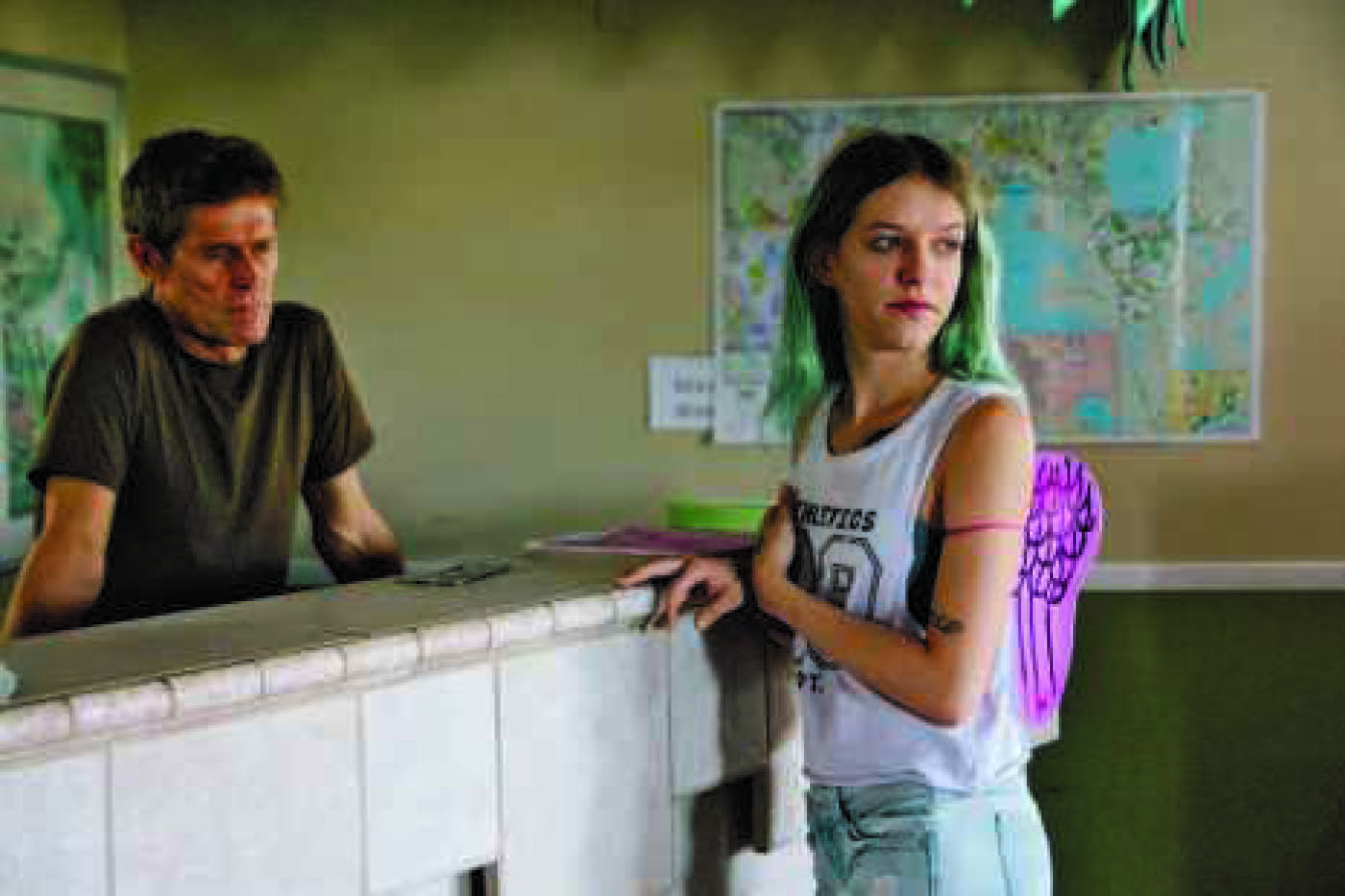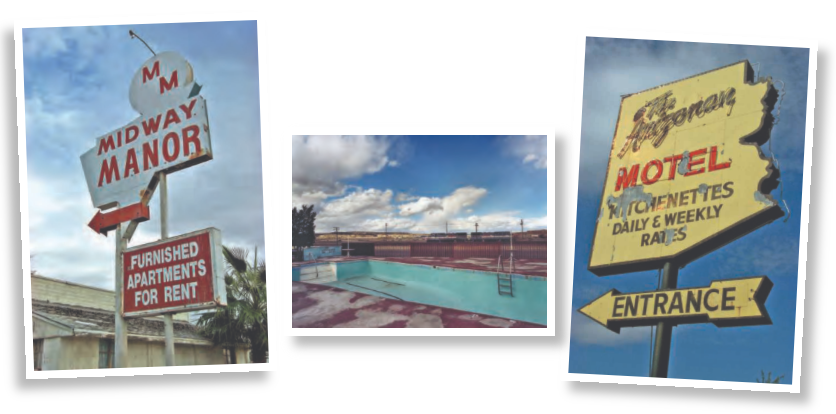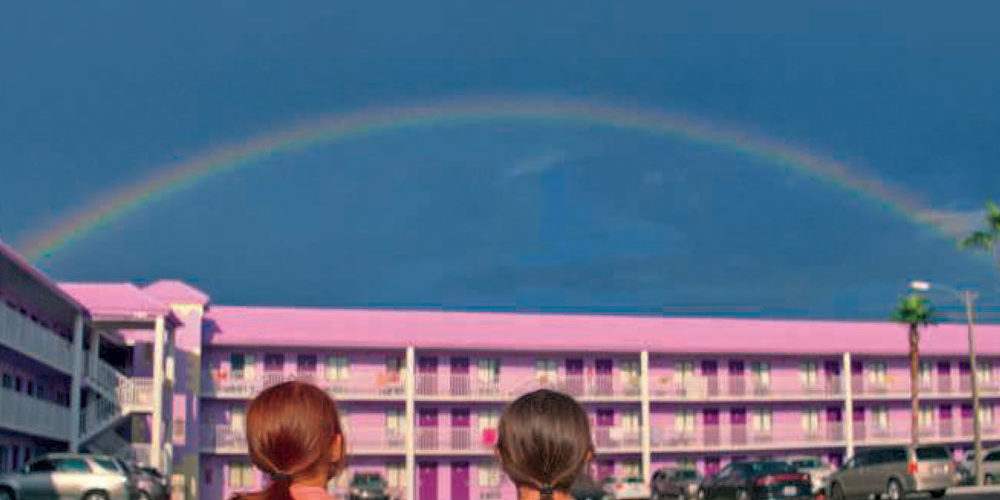Living at
the Motel
A New Type of
Overnight Guest

ABOVE: Still from the movie, The Florida Project.
By Elsa Court
A person having never set foot in an American motel will likely be able to conjure up a set of generic narratives associated with it, all more or less tenuously linked to the boom and subsequent pitfalls of the motoring industry in the U.S. of the 20th century. The history of the roadside motel in popular culture is a story of representations of freedoms taken, and marginal lives lived, narratives which dramatize the paradox of confinement and isolation with the new autonomy granted by the motel’s modern, “no-questions-asked” style of hospitality.
In Noir classics such as High Sierra (1941) and They Live by Night (1948), criminals on the run find refuge in out-of-the-way motels, places which grant them such anonymity and freedom that they can create, at least for a while, a simulacrum of domestic life. Not very much later, darker narratives have represented acts of deviance and sexual violence taking place with impunity within the socially blind structure of the motel, for example, in Vladimir Nabokov’s Lolita (1955) or Alfred Hitchcock’s Psycho (1960). Surprisingly, perhaps, precariousness and long-term poverty is a relative newcomer to the motel-life narrative.

TOP-LEFT: Humphrey Bogart in the movie, High Sierra.
TOP-RIGHT: Poster from High Sierra.
BOTTOM: Ida Lupino and Bogart in High Sierra.
Recently, Sean Baker’s The Florida Project (2017) brought attention to the not precisely recent yet relatively overlooked phenomenon of long-term motel living. Set on a strip of budget motor lodges on the outskirts of Orlando, Florida, the film portrays a population of long-term motel residents as the “hidden homeless.” The motel residents survive around urban communities and major tourist destinations, which lack affordable housing. The film is based on the conditions of living experienced by the residents of the Magic Castle, a real-life motel. In the shadow of Florida’s Disney World Resort, the motel brings in focus a surrounding leisure economy thriving on insecure, low-paying service jobs. One adult character in The Florida Project is fully employed as a waitress, yet her conditions of living are on a par with unemployed motel residents.

ABOVE: Poster from They Live By Night.
The film has brought media attention to a phenomenon that is harder to quantify or account for than people living on the streets. Motels, due to their lack of amenities and their locations on the side of highways or the outskirts of cities, tend to be cheaper than hotels. They are not designed for long-term living, yet their comparative affordability makes them accessible to the working poor, families who may be able to earn the price of a room on a weekly basis, but not the first and last month’s advance of a required deposit for an apartment rental. Credit score requirements may completely disqualify them from the residential market, leaving temporary accommodations as the only alternative.

ABOVE: Motel in Lancaster, Calif. Photo by Elizabeth Fladung.
Photographer Elizabeth Lloyd Fladung has documented motel homelessness in Los Angeles’ metropolitan area since the 1990s, bringing attention to the shortage of local shelters in and around the city. Her ongoing photo project has led her to talk to social workers and permanent motel residents to further document the tenuous link between low-income employment, wage-stagnation, and the current housing crisis. She points out that what started as an independent phenomenon is now encouraged by housing agencies and, in fact, by the state.
Faced with a shortage of state shelters, agencies have been striking deals with motel owners for years to house the welfare recipients of their communities. This subsidy of up to $1,200 a month worked for many motel owners because they were already accommodating many long-term occupants who turned to motels as a last resort.


ABOVE: Movie stills from The Florida Project.
My recent communication with the U.S. Department of Housing and Urban Development has confirmed that the phenomenon, which has long been known to social workers and local police authorities, now coincides with local initiatives to house homeless families in motels nationwide. In January 2017, according to Brian Sullivan, Public Affairs Specialist at the HUD, 10,558 vouchers for motel and hotel rooms were issued on a nightly basis nationwide, excluding New York City. Existing hidden homelessness, Sullivan said, is much harder to quantify, and for this reason is not taken into account by the yearly federal census, which takes place the third week of January every year, and relies on volunteers to count people living on the streets.
Twenty years ago, sociologists specializing in motel history asked whether hidden homelessness had really become a permanent group in American society, or whether they were a temporary phenomenon resulting from a temporary increase in poverty combined with a shortage in available housing. The increase in the urban population in the last ten years, combined with the economic recession and the stagnation of wages in the service industry, have made it more likely for middle-class households on declining incomes to resort to using budget motel rooms as semi-permanent accommodation.

ABOVE: The Quail Inn of Tucson, Ariz. Photo by Douglas Towne.
In Washington, D.C., the local government has resorted to placing homeless families in motels since the mid-1980s. A recent study by Virginia Commonwealth University concluded that there were 67,000 more modest-wage jobs than low-cost housing units in the suburban area around the city of Richmond, which explained the growing population of hidden homeless in the area. Similarly, when a motel in Bullhead City, Arizona, the Nevada Club Inn, closed its doors, it left the long-term occupants of its 77 rooms to await relocation. The city’s Homeless Task Force Leader Patty Jacques announced the event would lead to a community crisis, as several elderly residents would wind up on the streets.

LEFT: Midway Manor, Tucson, Ariz. Photo by Douglas Towne.
MIDDLE: Pool, New Mexico. Photo by Elizabeth Fladung.
RIGHT: The Arizonan Motel, Tucson. Photo by Douglas Towne.
Far from metropolitan areas, other motels make do with a new surge in road trip nostalgia tourism. In her nonfiction book Maximum Sunlight (2016), queer journalist and San Francisco resident Meagan Day describes the unlikely interior of a clown-themed motel as one of the key attractions of Tonopah, Nevada. She discovered this former miner’s town by accident while driving between Las Vegas and Reno. Located roughly 200 miles northwest of Las Vegas, Tonopah is pretty much the middle of nowhere, she is told, as far as the rest of America is concerned.
Yet the Clown Motel, due to its dated and eccentric outlook and its immediate proximity to a Gold Rush-era cemetery, has become an object of curiosity which has recently gained Tonopah modest internet fame. People come from all over the States to visit the Clown Motel, says Wilma, who works in the motel’s office, sometimes on the advice of their therapist. Others discover the Clown Motel online and visit it out of curiosity or fascination with quirky, off-grid Americana. One of them, Day observes, has sent himself on a self-appointed writer’s residence at the Clown Motel, which he documents on Twitter.
“If I recall,” Day wrote when I asked her whether she had witnessed long-term residents at the Clown Motel in Tonopah, “most of the precariously-housed people in Tonopah live in apartments and trailers, a fair number of which are also owned by the owner of the Clown.” The Clown, she writes, is mostly patronized by road trippers and truckers, because the poorest people in town can’t afford $40 a night. “I wouldn’t be surprised if desperate people sometimes stay there for less than a week in a pinch, but I don’t think they live there long-term.”

ABOVE: Clown Motel, Tonopah, Nev. Photo by Debra Jane Seltzer.
Pictures by Hannah Klein document the survival of the motel’s vintage outer structure as well as the overwhelming collection of clown figures inside. The images are reminiscent of the work of Stephen Shore in the 1970s, which highlighted the modest, fragile, yet colorful and omnipresent structures of roadside services, only revealing traces, but no direct evidence, of human presence. In both Shore’s and Klein’s photographs, relics from the pursuit of affordable comfort present an atomized picture of American society, which resonates with the motel’s contemporary embodiment of social isolation.

ABOVE: Motel Registration. Photo by Elizabeth Fladung.
ABOUT THE AUTHOR: Elsa Court is the author of The American Roadside in Émigré Literature, Film, and Photography 1955-85 (Palgrave, March 2020). Her work has appeared in The Financial Times, The Los Angeles Review of Books, The White Review, and Granta, among others. She teaches American Literature at Queen Mary University of London.
Did you enjoy this article? Join the SCA and get full access to all the content on this site. This article originally appeared in the SCA Journal, Spring 2020, Vol. 38, No. 1. The SCA Journal is a semi-annual publication and a member benefit of the Society for Commercial Archeology.
More Articles Join the SCA



